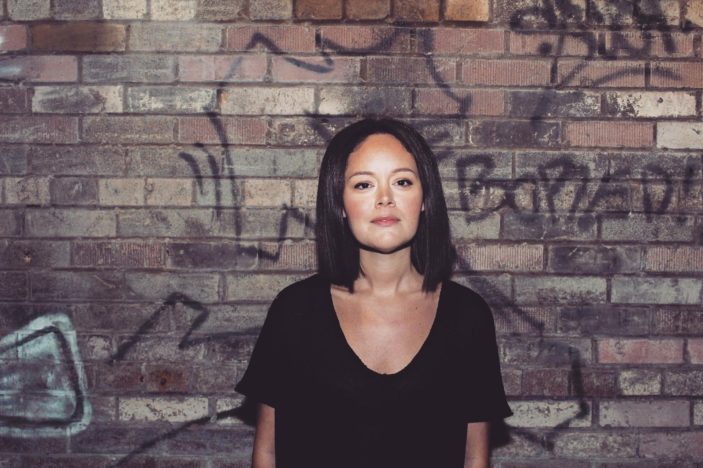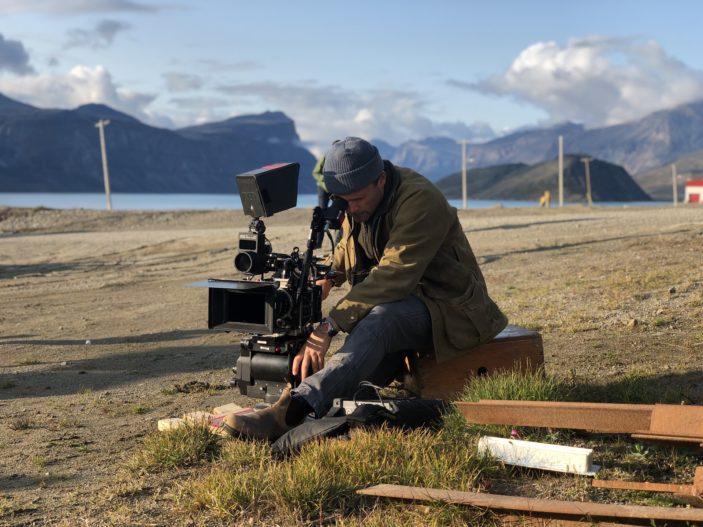
Having premiered at SXSW to rave reviews (including our own here) the horror/adventure film Slash/Back has more than announced filmmaker Nyla Innuksuk as a talent to take note of. Talking with Peter Gray during her time at the festival, the two spoke about the origins of the film’s story, the importance of incorporating her indigenous culture, and the inspiration behind its more horrific elements.
SXSW is always such an exciting festival to attend. You really do see the best, boldest, wildest films, and I went into Slash/Back knowing nothing, which is always the best way to approach a film. Where did the inspiration for this story originate?
I love movies. I am a movie nerd, and growing up I just loved those kind of adventure-horror movies, like The Goonies. Like we all did. And growing up in Nunavut, it was this magical place to kind of run around with your friends, so I always kind of thought it would be a great place for the setting of a movie like this. In the summertime, and this community of Pang is so special, because it has in June 11 days where the sun just doesn’t set. It just circles around the mountains, and it’s absolutely stunning and beautiful. And after a long winter, for part of which it just doesn’t get dark out. It is just this wonderful, amazing time, especially for kids (where) there is no expectation that kids are at home and in bed at nine o’clock at night because it’s just this once a year time where you can just go out and be fishing and hunting and camping… (just) hanging out with your friends. So it was this kind of bunch of different things (that) made this community kind of special for for a project like this one.
You’re making a film where nobody has ever made a feature, with first-time unknown actors too. Not an easy feat. How was that process in bringing it all to fruition?
Painful (laughs). It was such an amazing experience to make the movie, but it came with… I feel like I learned every lesson along the way. I really felt like, by the time we finished shooting, and we were all packed up and I was getting on the plane to leave, I was like “Okay, that’s how you make the movie”, and I’m paying (for it) now, but it was fantastic. And there were some great things that came out of the fact that, you know, we were working in a place where there’s a reason why there hasn’t been a movie made there. It’s really really challenging, but it just had to be made in a way that was, I think, a little unconventional. For me, seeing the girls that I’ve been working with for years, seeing them grow up and now being able to represent the movie and and be really proud of where they come from, is such a wonderful experience.
I was going to ask about the the casting of the girls. As you said, you’ve worked with some of them before, so did you immediately think of them for these roles or did you go out and scout?
Yeah, I had an idea of the characters and what their personalities (were). It started out a bit wet, but I initially shot a proof of concept before I had even found producers for the project, and so I went and did it (myself) rather than doing a traditional casting, which would have just been impossible. There’s no casting agents or anything like that, and even a formal audition process I think would have been weird. So instead I partnered with a little arts organisation and I found an amazing actor who does local theatre and has done some film and television work, and she helped me run these acting workshops for young teenagers and young women specifically. So through that process of doing acting workshops I was also giving them pages of the script, having them read scenes and trying in-person with (that) first.

When you mentioned The Goonies before, that was exactly the film I thought of when I was watching this because that’s very much a film I grew up with. This has that same mentality of just watching these kids together. You really nailed it with their chemistry because it all feels like so incredibly natural. And I’m just wondering did you ever just let them go off on their own in terms of the script? Or was it all very structured, because it really just felt like their banter and dialogue just comes off so naturally. It’s almost voyeuristic in a way, like a documentary. Did you just let them explore that?
I think that (came down to the) attachment to their work and also our cinematographer, Guy Godfree. Our schedules were so tight, so there wasn’t a tonne of necessary improvisation. The writing was done while we were hanging out with the girls, so it was this thing where how they were talking was influencing the script. So when they were reading (the script) back, they were like “Oh, this feels like something I would say”, and so certainly there were times when I was reading and asking “Does this sound like something you would say?”, and they would just tell me “No, this is so cringe!”
And the horror and sci-fi elements were another part of the film that I really took to. The alien creations and their aesthetic reminded me of the Leatherface design from The Texas Chainsaw Massacre. Where did that design originate from?
Definitely some of those 70s (characters) like Leatherface, that sort of thing is cool. We had this amazing contortionist, Troy, who would wear the “skin suits”, that’s what we’d call them, and seeing him walk around in the daytime was really kind of neat. I’m thinking of Halloween or something. I love horror, I love scary movies, that’s kind of the reason I got into movies. It’s such a foundational time, and so when it came to the creatures and and that sort of thing I did want to try and do as much practically as possible, and play with some of those practical effects. We had this really great team in Toronto that helped us cast our set (as) these moulds, and they built and painted these masks that Troy would then wear. If there was a scene with two aliens we also had Leo, who was a dancer, and he learned the similar movements to Troy.
Being in Australia the importance of Indigenous culture and taking back of the land is something we can identify with. For you, was it always an absolute necessity in incorporating the native language and referencing such structures?
It was, and in a lot of ways I wish I could have done it more. But because of a lot of things, including the impacts of colonisation, I don’t speak enough to do so, so it makes it difficult for me to (do the) writing and directing I have to do. Chelsea (Pruksy) who plays Leena, she’s the only one of the teenage cast who is fluent in Inuktitut. But my sister-in-law, for instance, she didn’t really start speaking English until she was 14, so it’s interesting because language is something that is being lost in a lot of these communities in the Arctic. There’s grandparents that only speak Inuktitut and don’t understand English, and then those who understand Inuktitut that respond to their parents in English, and they aren’t necessarily passing down English to their children or prioritising that. That was something that we wanted to be a part of the film, for sure.
Even at one point I was playing with the idea of not having any subtitles in the Inuktitut language sections. I didn’t want to limit people in any way, but I wanted to make an experience that if you were an Inuktitut language speaker that you would have a bit of a different understanding, and it would feel like it was being made for you.
Slash/Back is screening as part of this year’s SXSW Film Festival, which is being presented in-person and virtually between March 11th and 20th, 2022. For more information head to the official SXSW website.
